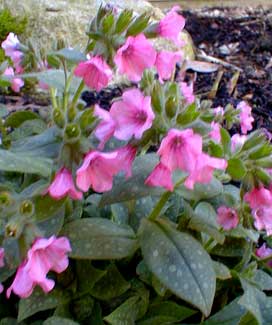
'Dora Bielefeld' Lungwort; or, Spotted Comfrey
"I have been but thy transient flower,
Thou wert my god divine."
-Charlotte Bronte
(1816-1855)
(1816-1855)
Pulmonaria saccarhata 'Dora Bielefeld' Lungwort or Bethelehem Sage is an early blooming lungwort in full flower starting early March, with its silver-speckled leaves not far behind joining the blooms.
The flowers are clear pink & do not age to blue as do other lungworts. When the flowers are finally finished, the speckly leaves retain their ornamental authority most of the rest of the year, dying back in winter.
Dora best likes semi-shade to shade, with moist well draining soil, but will tolerate a sunnier aspect. It can also be seen doing pretty well in dryer shade gardens; but it bushes up much more nicely into a big round clump of leaves when there is adequate moisture.
Cold-hardy to minus forty to minus thirty degrees, & not much liked by deer, this is a hardy naturalizer that makes a good groundcover plant or specimen perennial. The leaves can clump up to a foot of height, & spread twenty inches.
Pulmonaria acquired both its genus name & its unlovely common name "Lungwort" from an old belief that the plant was useful in treating lung diseases. For this same alleged value it has also been called Oak Lungs & Lungmoss. This belief in its curative prowess was based on no observable reaction to its use, but upon a mystical faith called the Doctrine of Signatures which asserts that God placed a mark of usefulness on herbs. The spotted leaves were viewed as God's signature-mark informing mortals that the plant was placed on earth to be used for treating diseased lungs.
Despite a level of antioxidant content that could be regarded as healthful on a general level (in the same way that antioxidants in strawberries & russet potatoes are healthful), there is in reality no effective connection between lungworts & lung function. But lungworts do contain glycopeptide, an anticoagulant potentially harmful to individuals with internal injuries, so the patient is guaranteed risks without benifits.
Sad to say, faddish modern uses of sundry herbal "medicines" are only rarely more soundly based than the absurd assumptons of the outmoded Doctrine of Signtures fairy tale. All too often today's most popular herbs are the ones that are thoroughly bogus when it comes to specific health claims, but people swear by them even so, because just as with the Doctrine of Signatures, it's a matter of faith, not outcome. So it's not like we've come a long way baby & can stand aloft scoffing the superstitions of yesteryear. We are those people.
P. longifolia'Bertram Anderson'